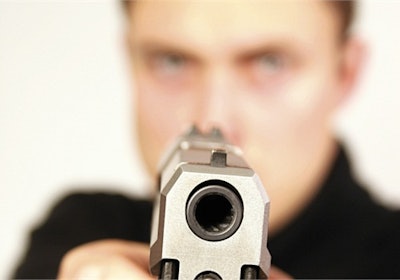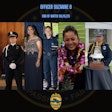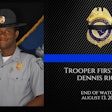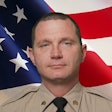
If you have been in law enforcement for any length of time, odds are the name of Michael Lee Platt is not wholly unfamiliar to you.
Nor should it be. When it comes to cautionary parables in the world of officer survival, thankfully few men have such bloody legacies. Platt's infamy was assured on April 11, 1986, when an eight-man team of federal agents took down Platt and William Russell Matix in what became known as the Miami FBI shootout.
While Platt and Matix were mortally wounded during the shootout, they were not incapacitated. Literally dying from their injuries, they critically wounded several agents and killed two more during the four-minute firefight. A 1988 TV movie starring David Soul and Michael Gross featured a painstakingly accurate recreation of the shootout. That reenactment, a staple of officer safety training seminars, can be found on YouTube today.
The killing of law enforcement personnel is hardly unique to the FBI Miami Shootout; nor is the loss of multiple officers in a single incident anything new. But what shootings such as the Miami incident illustrate is the reality of a differently minded offender, one who will take the fight to officers with the mindset to kill regardless of the cost.
If there is another common denominator to these killers it is this—a complete hatred for law enforcement.
The One-Percenters
The ignoble distinction of having shot and killed the greatest number of FBI agents belongs not to Platt, but to Baby Face Nelson. Two of those agents, Herman Hollis and Samuel Cowley, were killed after Nelson had sustained mortal injuries during a 1934 shootout in the Chicago suburb of Barrington, Ill.
On that day some 30 people bore witness that Nelson was struck by the agents' submachine gun and shotgun fire before advancing on them. Despite suffering a total of 17 bullet wounds, Nelson was able to kill both lawmen.
Nelson was not congenitally inured to pain, or experiencing some chemically induced superhuman strength at the time of the shooting. And yet, like Platt, he was able to bring death to those who killed him. What these criminals and others like them possess is a mindset committed to executing whatever is to be accomplished at a given moment, whatever the cost.
And that cost may not even be recognized. Like the deer that has no concept of death and takes flight despite a hunter's bull's-eye, once wounded these men do not acknowledge the reality of their imminent demise. But unlike a wounded deer, they may fight back with a ferocity belying their stature. At five feet four and 133 pounds, Nelson did not have the appearance of a warrior, but he was undeniably deadly.
Such men are routinely discussed and dissected in officer safety seminars and military debriefings. But while words such as "madmen" and "berserkers" may enter the conversation, there has not been any formal classification accorded them. Colloquially, they are often referred to as "one-percenters"—that single person out of a hundred who possesses a mindset that is as respected as it is feared.
And like Nelson such men often live difficult lives that endow them with compensatory skillsets denied those born to more fortuitous circumstances. Their backgrounds play a considerable role in giving them an "it's me against the world" mindset.
"Diamonds are forged under intense pressure; the strongest blades are put through hellfire so as to become unbreakable," notes martial arts instructor Dominick Izzo, a former Round Lakes Heights, Ill., police officer. "People are subjected to similar kinds of forces—both physical and psychological—during their lives. They can be the most professional or the most unprofessional people you'll come across, and may come from rich or poor backgrounds. But the same pressures that fortify them in some areas can break them in others and render them monsters in the process.
"They don't fit into society and ultimately that's what gives them their edge," Izzo observes. "They're willing to do what normal people are not willing to do and that's what gives them the 'one-up' in field confrontations."
One-percenters are not necessarily criminals. And when you're in combat, you want one on your side, says Dave Lewis of the Cleveland County (Okla.) Sheriffs Office. "When they're good guys and die hard, we give them the Medal of Honor, but when they're the bad guys, we hope that we never run into another one like them," he adds.
Confronting the Threat
The Damoclean Sword of law enforcement is that in digging for dirtbags we occasionally hit the mother lode. And too much of a bad thing can be fatal.
When confronting one-percenters, officers need to take any and all precautions possible. Just knowing what they're in for ahead of time can be a huge advantage in itself, affording them the opportunity to make appropriate transitions in personnel and logistics.
FBI agents knew that a Ruger Mini-14 had been used in some of Platt and Matix's robberies. Yet the agents did not compensate with commensurately stronger firepower of their own before engaging the military veterans.
Instead of "bringing a bigger weapon" and adopting better tactical strategies, the agents effectively dug a hole for themselves in a situation that soon became further complicated. Impacts between the suspects' vehicle and the agents' during the firefight resulted in the agents' weapons getting jarred loose from their hands. Also working against the agents was an absence of body armor, as well as the loss of eyewear that effectively blinded one of their best shooters. While the timeliness with which Platt might have been otherwise put down is subject to speculation, a selection of different tactics and logistics would have doubtlessly resulted in a far better ending.
Street cops may find themselves acting under even greater deficiencies than the agents who faced Platt and Matix. For one, street cops are lucky to have backup on scene. For another, street cops are downright fortunate if they know the true nature of the opposition upon contact.
Not that such men do not sometimes telegraph their intent. Platt went out of his way to make a conspicuous display of his firearm through the driver's window prior to the attempted stop; disgraced former LAPD officer Christopher Dorner dumped his uniform gear within eyeline of a police station, almost as though daring someone to confront him before he went on his killing spree. The question is whether such telltale signs will be recognized and acted upon by officers.
Despite the stigma attached to it, "profiling" remains a staple in the officer safety canon and evaluating a person's potential for violence via his appearance and conduct is sound protocol. Moreover, the warrior mindset is not easily camouflaged; more rarely still do the people who have that mindset even attempt to hide it. Forsaking any affected nuances of a conman and offering no conciliatory smile, the one-percenter may instead display a conspicuous lack of empathy and a physicality hardened by "yard time."
One-percenters also don't behave like other criminals. Most suspects want nothing more than to evade law enforcement personnel, and any time they strike out at officers escape is usually their goal. One-percenters don't think like that. Enamored of the forthcoming battle, they may entrench themselves or take that fight to you. But rest assured, they are in it for the long haul.
Strategic and Tactical Considerations
And so are you. That's why it's imperative that you adjust accordingly.
The one-percenters' willingness to engage can be used against them. Once opportunities for freedom have been bypassed and they have taken the fight to you, a case could be made that they are playing into your hands. At the very least by committing themselves to the crime scene they are making your mission of arresting them easier in one regard—the prospect of chasing them down drops to the bottom of your concern list. This should temper any desire to close quarters on them. Indeed, if ever a situation calls for sufficient cover and concealment it is any firefight involving such men. Remember that you can afford to put distance between yourself and the bad guys and await additional assistance should it be available.
There are those for whom "shoot to wound" doesn't enter the equation even so much as a consideration. Bonnie and Clyde survived multiple shootouts, in part because of their willingness to kill. They remain among law enforcement's deadliest enemies with nine officers killed between them, most—if not all—at the hands of Clyde Barrow. Factoring this into the equation, the 1934 ambush of these public enemies seems less a matter of overkill than reasonable prudence.
Whether or not you have the advantage of setting up an ambush ahead of time, it is imperative to be tactically flexible and think outside the box. Look at past situations and ask yourself what other options might have proven effective.
The 1997 North Hollywood shootout lasted for forty-four minutes, much of it taking place in a static environment right in front of a Bank of America branch. Both shooters absorbed numerous officers' rounds without effect while tracking back and forth in front of the bank's facade. In hindsight we have to ask: What other weapons or tactics might have been brought to bear on the men? Might an officer have gained access to the roof via the rear of the bank? If so, how would the suspects have fared had less conventional weaponry been deployed, such as the tossing of a couple of Molotov cocktails down on them? Could additional armored trucks have been commandeered and the suspects flattened?
Of course, the ability and willingness to move works both ways, and one thing you may not want to do is commit yourself to one location. Hollis and Cowley failed to move when Nelson advanced on them. Given their mindsets, how many cops might hesitate to give ground when it might be the most prudent thing to do?
The One-Shot Myth
Taking the one-percenter out is problematic. You're no doubt familiar with the extremely popular cable television series "The Walking Dead" in which you have to shoot the brain to put down the monster. This often holds true in getting the one-percenters to go "lights out," too.
That people don't die in real life with choreographed finesse as they do in movies is well known by street cops. Shootings are messy affairs with the "one-shot stop" more aspired to than achieved.
But immobilizing suspects can perform the equivalent of a firebreak, isolating the threat if not incapacitating it. If for any reason you find yourself incapable of executing a central nervous system shot, consider sweeping the legs out from under a suspect. Australia's otherwise well-armored Ned Kelly was taken down by a series of shots to his groin.
While hits on any exposed area are better than none, the critical nature of shot placement is illustrated in Skokie, Ill., police officer Tim Gramins' shootout with bank robbery suspect Raymond Maddox.
"There were 17 total hits on his body including three fatal shots to his head, a couple to his torso, and one to his abdomen," Gramins says. "Which means that even though Maddox was mortally wounded before the head shots, he was still able to engage me. And these rounds were from a .45 caliber Glock."
Train to Live
Regardless of the number of rounds an officer deploys during the course of a successful firefight, the bullet- and bean counters will have their say. But that officer's ability to still be around to answer their questions forms the foundation for the profession's coda of "better to be tried by 12 than carried by six."
Unfortunately, those 12 can prove an omnipresent distraction according to Izzo.
"The presence of the word 'liability' in officers' minds puts a damper on officers' mindsets. Liability threatens their jobs, their homes, their pensions, and their families—small wonder that officers are being conditioned to perform no longer at the elite level for which they were trained. It translates into an 'I am no longer the elite cop that I once thought I was' mindset. And it only gets worse the longer they are on the job."
Brian McKenna, co-author of the book "Officer Down! Lessons from the Streets" and owner of Winning Edge Training, agrees.
"Many modern agencies are so gun shy of lawsuits and so PR oriented that they try to scare their officers into doing the right thing when it comes to use of force. At the same time, they often fail to invest the time and money necessary to really train officers in proper threat assessment and use-of-force decision making. Often, the result is cops who are hesitant, fearful, unsure of themselves, and afraid to shoot when necessary. That is not the kind of cop you want around when it comes to dealing with predatory one-percenters. Administrators need to realize that their officers are the last line of defense against these predators and that they owe it to the public to field officers who can handle them."
Until administrators embrace that mindset, it may well be up to trainers to compensate.
"The important role of trainers here cannot be overstated," says McKenna. "Whereas administrators are often concerned that a mentally prepared officer will be 'trigger happy,' good trainers know that the opposite is true. A mentally prepared officer will be more confident, and a more confident officer has better control, thinks clearer, and makes better decisions than one who is unsure of himself. They also exude self-confidence, which will often discourage violent resistance (not always of course, but often). Trainers need to build warriors who are ready and willing to kill when necessary, but only when necessary."
McKenna likes Michael D. Janich's workable definition of "warrior" within the context of the profession: "Although we may do our best to avoid trouble, sometimes trouble insists on finding us. When that happens, when the time for talk is over, warriors act. They flip the switch and act decisively—ruthlessly if necessary—to preserve and defend the things they hold dear. And when the fight is over, they turn off the switch and continue to cherish the things they valued enough to defend."
Regardless of their tenure, it might be wise for officers to consider the mindset of our seventh president. Discussing a man who'd attempted to kill him and ended up dead for his efforts, Andrew Jackson commented, "If he had shot me through the brain, sir, I should still have killed him."
Officers might then ask: Will my attackers have Old Hickory's mindset?
Or will I?














